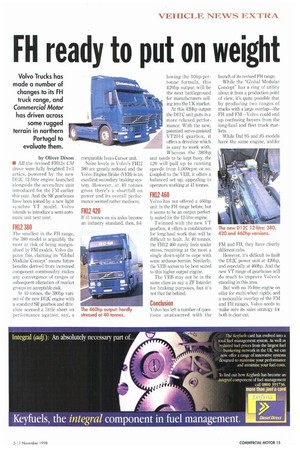FH ready to put on weight
Page 17

If you've noticed an error in this article please click here to report it so we can fix it.
Volvo Trucks has made a number of changes to its FH truck range, and Commercial Motor has driven across some rugged terrain in northern Portugal to evaluate them.
by Oliver Dixon MI All the revised 1-.1-112s
drove were fully freighted 2+3 artics, powered by the new 1)12C 12-litre engine launched alongside the seven-litre unit introduced for the FM earlier this year. And the SR gearboxes have been joined by a new light synchro VT model. Volvo intends to introduce a semi-automatic unit next year.
FH12 380
The smallest in the FU range, the 380 model is arguably the most at risk of being marginalised by FM models. Volvo disputes this, claiming its "Global Modular Concept" means future benefits derived from increased component commonality makes any convergence of ranges or subsequent alienation of market groups an acceptable risk.
At 40 tonnes, the 3801m variant of the new D12C engine with a standard SR gearbox and driveline seemed a little short on performance against, say, a comparable Iveco Cursor unit.
Noise levels in Volvo's F1112 380 are greatly reduced and the Volvo Engine Brake (VEB) is an excellent secondary braking system. However, at 40 tonnes gross there's a shortfall on power and its overall performance seemed rather mediocre.
FH12 420
If 41 tonnes on six axles become an industry standard, then, fol lowing the 10hp-pertonne formula, this 420hp output will be the next battleground for manufacturers selling into the UK market.
At this 420hp output the D12 C unit puts in a more relaxed performance. With the new, patented servo-assisted VT2014 gearbox, it offers a driveline which is easy to work with. Whereas the 380hp unit needs to be kept busy, the 420 will pull up to running speeds from 1,000rpm or so. Coupled to the VEB, it offers a balanced set up, appealing to operators working at 41 tonnes.
FH12 460
Volvo has not offered a 460hp unit in the FH range before, but it seems to be an output perfectly suited for the 12-litre engine.
Twinned with the new VT gearbox, it offers a combination for long-haul work that will be difficult to fault. At 40 tonnes, the FH12 460 rarely feels under stress, requiring at the most a single down-split to cope with some arduous terrain. Similarly, the VEB seems to be best suited to this higher output engine, The VEB may not be in the same class as say a ZF hitarder for braking purposes, but it's not that far behind.
Conclusion
Volvo has left a number of questions unanswered with the launch of its revised FH range.
While the "Global Modular Concept" has a ring of utility about it from a production point of view, it's quite possible that by producing two ranges of trucks with a large overlap—the FH and FM—Volvo could end up confusing buyers from the long-haul and fleet truck markets.
While Daf 95 and 85 models have the same engine, unlike FM and FH, they have clearly different cabs.
However, it's difficult to fault the D12C power unit at 420hp, and especially at 460hp. And the new VT range of gearboxes will do much to improve Volvo's standing in this area.
But with no 1.0-litre engine on offer for multi-wheel rigids, and a noticeable overlap of the FM and FH ranges, Volvo needs to make sure its sales strategy for both is clear cut.


























































































































